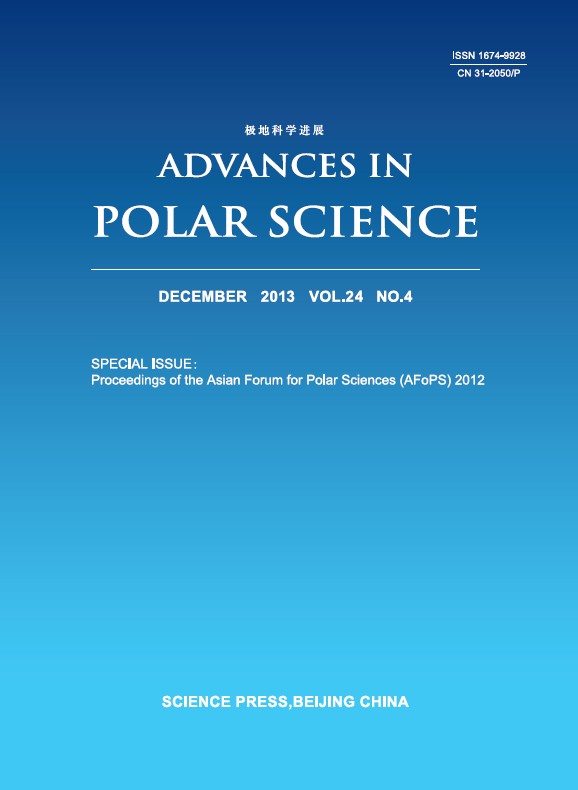|
|
Call for Papers for Two Special Issues of Advances in Polar Science
2013, 24 (4-English):
344-345.
Dear Colleagues, We invite you to submit a article, a review, a letter, or a trend to a special issue on“The rapid change of Arctic sea ice and its possible effects on high- and mid-latitude weather and climate”, or another special issue on “The current status on the ecosystem of Antarctic Peninsula” of the Journal Advances in Polar Science (APS). APS is an international, peer-reviewed journal jointly sponsored by the Polar Research Institute of China (PRIC) and the Chinese Arctic and Antarctic Administration. It is a quarterly journal published in March, June, September and December by Science Press of China and circulated internationally. Article publishing in APS is free of charge thanks to generous funding from PRIC. For more details, please visit the websites http://mc03.manuscriptcentral.com/apsci or http://journal. polar.gov.cn/CN/volumn/current.shtml. Please respond to indicate whether or not you will accept this invitation to offer a paper. We kindly request that you confirm your commitment ASAP and please provide a preliminary title and a brief description of the proposed paper. Thank you in advance for your consideration to submit an article to one of the two special issues, and we encourage you to share this announcement broadly with interested colleagues. Any queries should be addressed to journal@pric.gov.cn I Special Issue on “The Rapid Change of Arctic Sea Ice and itsPossible Effects on High- and Mid-Latitude Weather and Climate” Rapid changes of Arctic sea ice cover have been in the focus of the international research community in recent years. Quite a few of nations have completed a large number of related surveys and research projects in the Arctic Ocean. Up to now, China has performed five research cruises to the Arctic Ocean resulting with a significant number of research output, and China is now to implement the 6th cruise to the Arctic Ocean in the summer of 2014. APS is preparing to publish the special issue at the end of 2014, providing an international forum to summarize the recent advances on this important topic. Scientific articles on the following research themes fit well within the scope of this special issue: (1) Future trends of Arctic rapidly changing sea ice – will there possibly be no sea ice in summer later in the 21st century; (2) Key factors controlling the rapid changes in the Arctic sea ice; (3) Differences of Arctic and Antarctic sea ice changes and their causes; (4) Why do the numerical simulation results deviate significantly from in-situ analyses; (5) Rapid change of Arctic sea ice and its linkages on climate in the high latitudes of the Northern Hemisphere; (6) The impact of Arctic sea ice changes on the weather and climate in China; (7) Forcing and response mechanisms of the Arctic tropospheric and stratospheric atmospheric circulation and ocean circulation on the changes in the Arctic sea ice; (8) Linkage of Arctic atmospheric circulation and westerly circulation changes; (9) Economic and social assessment of Arctic sea ice rapid decline. The agenda of this issue is the following: •Paper submission deadline: 31 May 2014 •Final acceptance deadline: 15 October 2014 •Publication: December 2014 Guest Editors Prof. Matti Leppäranta, Department of Physics, University of Helsinki, Finland Prof. Timo Vihma, Finnish Meteorological Institute, Finland Prof. Huiding Wu, National Marine Environmental Forecasting Center, China II Special Issue on “The Current Status on the Ecosystem of Antarctic Peninsula” It is obvious that the weather in the Antarctic Peninsula is becoming warmer in recent decades. It will influence the ecosystem in and around Antarctic Peninsula, and also provide a more suitable surviving “environment” for alien species. Increased knowledge of the status on the Antarctic Peninsula ecosystem can be used for the conservation and management of its ecosystem and for developing scenarios of its future state. APS is preparing to publish a special issue entitled “The current status on the ecosystem of Antarctic Peninsula”. This issue will provide a forum summarizing the recent advances on expeditions and research based or focused on the ecosystems of Antarctic Peninsula. The scientific articles stressing the following research themes may fit well within the scope of this special issue: (1) Past and present biodiversity across terrestrial, limnological, glacial and marine environments (2) Past and present environments (3) Interactions between organisms and environments (4) Interactions between organisms and organisms (5) Alien species (6) Global change and human activities on ecosystem effects This special issue is scheduled to publish in March of 2015, which was in memory of the 30th anniversary of foundation of Chinese Great Wall Station. The agenda of this issue is the following: •Paper submission deadline: 31 June, 2014 •Final acceptance deadline: 30 November, 2014 •Publication: March of 2015 Guest editors Prof. José Retamales, Chilean Antarctic Institute Prof. Liguang Sun, University of Science and Technology of China Associate Prof. Yong Yu, Leader of Chinese Great Wall Station, 29th CHINARE, Polar Research Institute of China
Related Articles |
Metrics
|

